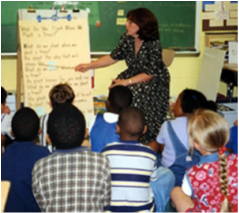 Shared reading -- a concept conceived by Don Holdaway in 1979 as a way to re-create what happens when parents read aloud to their babies at home -- has evolved for classroom use through the years. Shared reading involves enlarged text whether through the use of big books, poster, or projected onto an interactive whiteboard or SMART board so that all students can see, follow along and eventually read along with the lead reader (usually the teacher). Sharon Gill (2006) states: "Shared reading provides repeated readings of predictable texts and poems, building student’s sight-word vocabularies, fluency, and phonics knowledge during enjoyable and successful reading experiences." One benefit of shared reading is that a teacher can focus on targeted skills in a guided way. National Reading Panel results show that teaching phonics in the context of shared reading has the benefit of showing students how phonics knowledge is used in real reading. Since shared reading is usually used with poems and/or short predictive text, it lends it's self very well with teaching onset and rime with our younger readers. Shared reading has also been recomend for use with english language learners and readers who struggle because of the guided aspect and because of the benefit of repeated readings of the text used. Children have the opportunity to interact with and behave like successful reader and teachers can demonstrate strategies usued by successful readers Sharon Gill says. (Gill & Isam, 2011) Five Steps For Shared Reading
Thank you for reading... Gill, S. R. (2006). Teaching Rimes With Shared Reading. The Reading Teacher, 60(2), 191-193. doi:10.1598/rt.60.2.9 Gill, S. R., & Islam, C. (2011). Shared Reading Goes High-Tech. The Reading Teacher, 65(3), 224-227. doi:10.1002/trtr.01028
0 Comments
Leave a Reply. |
AuthorPearl Garden, Ed.D has completed her dissertation research involving understanding the vocabulary instruction practices of early grade teachers. She has a passion for the new and novice educator, and it is her goal to help educators tackle the achievement gap with her research findings. She will use this blog to share what she has learned in “pearls of literacy”. The ideas come from her dissertation titled “A Content Analysis of the Vocabulary Instruction Habits by Early Grade Teachers”. Archives
January 2024
Categories |
 RSS Feed
RSS Feed